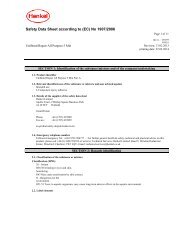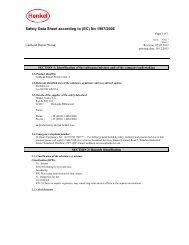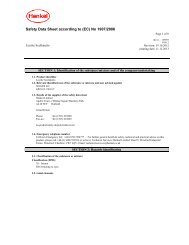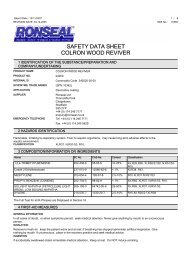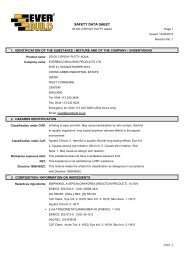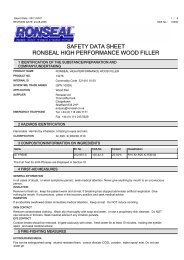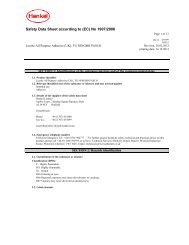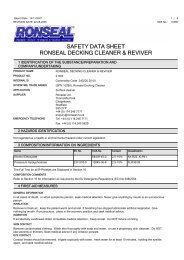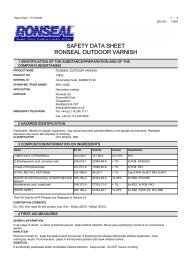SAFETY DATA SHEET Zinsser B-I-N® Primer Sealer - Toolbank
SAFETY DATA SHEET Zinsser B-I-N® Primer Sealer - Toolbank
SAFETY DATA SHEET Zinsser B-I-N® Primer Sealer - Toolbank
Create successful ePaper yourself
Turn your PDF publications into a flip-book with our unique Google optimized e-Paper software.
Report Date : 22/05/2012REVISION DATE 22/05/2012<strong>SAFETY</strong> <strong>DATA</strong> <strong>SHEET</strong><strong>Zinsser</strong> B-I-<strong>N®</strong> <strong>Primer</strong> <strong>Sealer</strong>1 IDENTIFICATION OF THE SUBSTANCE/PREPARATION AND OF THE COMPANY/UNDERTAKINGPRODUCT NAMEPRODUCT NO.APPLICATIONSUPPLIERCONTACT PERSONEMERGENCY TELEPHONE<strong>Zinsser</strong> B-I-<strong>N®</strong> <strong>Primer</strong> <strong>Sealer</strong>ZN7020001A brush-/ roller-/ spray-applied single-component, solvent-borne coating. Intended for use as a primer/coating for stainedwalls and ceilings.William <strong>Zinsser</strong> (UK) LtdPortobello Industrial EstateBirtleyCounty DurhamEnglandDH3 2RE+44(0)191 4106611+44(0)191 4920125enquiries@tor-coatings.comian.mccormack@tor-coatings.com+44(0)1865 407333 (NCEC)2 HAZARDS IDENTIFICATIONHighly flammableCLASSIFICATION (1999/45)F;R11.ENVIRONMENTThe product is not expected to be hazardous to the environment.PHYSICAL AND CHEMICAL HAZARDSThe product is highly flammable, and explosive vapours/air mixtures may be formed even at normal room temperatures.HUMAN HEALTHIn high concentrations, vapours and spray mists are narcotic and may cause headache, fatigue, dizziness and nausea. Acts as a defatting agent on skin. Maycause cracking of skin, and eczema.3 COMPOSITION/INFORMATION ON INGREDIENTSNameEC No.CAS-No. Content %Classification (67/548/EEC)ETHANOL200-578-664-17-5 25-50%F;R11METHANOL200-659-667-56-1 1.0-2.5%F;R11 T;R23/24/25,R39/23/24/25The Full Text for all R-Phrases is Displayed in Section 164 FIRST-AID MEASURESGENERAL INFORMATIONGeneral first aid, rest, warmth and fresh air. Do not give victim anything to drink if they are unconscious. Get medical attention if any discomfort continues.INHALATIONPlace unconscious person on the side in the recovery position and ensure breathing can take place. If respiratory problems, artificial respiration/oxygen. Getmedical attention if any discomfort continues.INGESTIONImmediately rinse mouth and drink plenty of water or milk. Keep person under observation. Do not induce vomiting. If vomiting occurs, keep head low. Transportimmediately to hospital and bring along these instructions.SKIN CONTACTUse appropriate hand lotion to prevent defatting and cracking of skin. Immediately remove contaminated clothing. Wash off promptly and flush contaminated skinwith water. Promptly remove clothing if soaked through and flush skin with water.EYE CONTACTMake sure to remove any contact lenses from the eyes before rinsing. Promptly wash eyes with plenty of water while lifting the eye lids. Get medical attentionpromptly if symptoms occur after washing.5 FIRE-FIGHTING MEASURES1 / 5
Report Date : 22/05/2012REVISION DATE 22/05/2012<strong>Zinsser</strong> B-I-<strong>N®</strong> <strong>Primer</strong> <strong>Sealer</strong>EXTINGUISHING MEDIAFire can be extinguished using: Water spray, fog or mist. Foam, carbon dioxide or dry powder. Dry chemicals, sand, dolomite etc. Do not use water jet as anextinguisher, as this will spread the fire.SPECIAL FIRE FIGHTING PROCEDURESUse pressurised air mask if product is involved in a fire. Cool containers exposed to flames with water until well after the fire is out. Keep run-off water out ofsewers and water sources. Dike for water control.UNUSUAL FIRE & EXPLOSION HAZARDSFire causes formation of toxic gases.PROTECTIVE MEASURES IN FIRESelf contained breathing apparatus and full protective clothing must be worn in case of fire.6 ACCIDENTAL RELEASE MEASURESPERSONAL PRECAUTIONSWear protective clothing as described in Section 8 of this safety data sheet.ENVIRONMENTAL PRECAUTIONSSpillages or uncontrolled discharges into watercourses must be IMMEDIATELY alerted to the Environmental Agency or other appropriate regulatory body.SPILL CLEAN UP METHODSKeep combustibles away from spilled material. Extinguish all ignition sources. Avoid sparks, flames, heat and smoking. Ventilate. Absorb in vermiculite, drysand or earth and place into containers. Wash thoroughly after dealing with a spillage.7 HANDLING AND STORAGEUSAGE PRECAUTIONSKeep away from heat, sparks and open flame. Avoid spilling, skin and eye contact. Ventilate well, avoid breathing vapours. Use approved respirator if aircontamination is above accepted level. Vapours are heavier than air and may spread near ground to sources of ignition.STORAGE PRECAUTIONSFlammable/combustible - Keep away from oxidisers, heat and flames. Store in tightly closed original container in a dry, cool and well-ventilated place. Keep inoriginal container. Avoid contact with oxidising agents.STORAGE CLASSFlammable liquid storage.8 EXPOSURE CONTROLS/PERSONAL PROTECTIONNameSTDTWA - 8 HrsSTEL - 15 MinNotesETHANOLWEL1000 ppm 1920 mg/m3METHANOLWEL 200 ppm(Sk) 266 mg/m3(Sk) 250 ppm(Sk) 333 mg/m3(Sk)WEL = Workplace Exposure Limit.INGREDIENT COMMENTSWEL = Workplace Exposure LimitsPROTECTIVE EQUIPMENTPROCESS CONDITIONSProvide eyewash station.ENGINEERING MEASURESProvide adequate ventilation, including appropriate local extraction, to ensure that the defined occupational exposure limit is not exceeded. All handling to takeplace in well-ventilated area.RESPIRATORY EQUIPMENTProvide adequate ventilation. Observe Occupational Exposure Limits and minimise the risk of inhalation of vapours. At work in confined or poorly ventilatedspaces, respiratory protection with air supply must be used. Wear mask supplied with: Gas cartridge suitable for organic substances.HAND PROTECTIONFor prolonged or repeated skin contact use suitable protective gloves. Use protective gloves made of: Neoprene. Nitrile. Rubber (natural, latex).EYE PROTECTIONWear splash-proof eye goggles to prevent any possibility of eye contact.OTHER PROTECTIONWear appropriate clothing to prevent any possibility of skin contact.2 / 5
Report Date : 22/05/2012REVISION DATE 22/05/2012<strong>Zinsser</strong> B-I-<strong>N®</strong> <strong>Primer</strong> <strong>Sealer</strong>HYGIENE MEASURESDO NOT SMOKE IN WORK AREA! Wash at the end of each work shift and before eating, smoking and using the toilet. Promptly remove any clothing thatbecomes contaminated. Use appropriate skin cream to prevent drying of skin. When using do not eat, drink or smoke.9 PHYSICAL AND CHEMICAL PROPERTIESAPPEARANCECOLOURODOURSOLUBILITYLiquidWhite.Odour of alcohol.Partially miscible with water.RELATIVE DENSITYVAPOUR DENSITY (air=1)FLASH POINT (°C)FLAMMABILITY LIMIT - LOWER(%) 3.5FLAMMABILITY LIMIT - UPPER(%) 19.01.22 Approx. @20°C.Heavier than air12°C. CC (Closed cup).VOLATILE ORGANIC COMPOUND (VOC) Cat A/i :
Report Date : 22/05/2012REVISION DATE 22/05/2012NameEcotoxicityMETHANOL<strong>Zinsser</strong> B-I-<strong>N®</strong> <strong>Primer</strong> <strong>Sealer</strong>Not regarded as dangerous for the environment. The product must not be allowed to enter drains or water courses. Dangerous to aquatic life in highconcentrations.LC 50, 96 Hrs, Fish mg/l >10000EC 50, 48 Hrs, Daphnia, mg/l >10000MobilityThe product is soluble in water.Bioaccumulative potentialThe product is not bioaccumulating.DegradabilityThe product is readily biodegradable.NameEcotoxicityETHANOLNot considered dangerous to aquatic organisms. The product must not be allowed to enter drains or water courses.LC 50, 96 Hrs, Fish mg/l 13000 - 16000EC 50, 48 Hrs, Daphnia, mg/l 5680 - 7710MobilityThe product is soluble in water. The product contains organic solvents which will evaporate easily from all surfaces.Bioaccumulative potentialThe product does not contain any substances expected to be bioaccumulating.DegradabilityThe product is readily biodegradable.13 DISPOSAL CONSIDERATIONSGENERAL INFORMATIONWaste to be treated as controlled waste. Disposal to licensed waste disposal site in accordance with local Waste Disposal Authority.DISPOSAL METHODSDispose of waste and residues in accordance with local authority requirements. Make sure containers are empty before discarding (explosion risk). Absorb invermiculite or dry sand and dispose of at a licenced hazardous waste collection point.14 TRANSPORT INFORMATIONFLAMMABLELIQUID3PROPER SHIPPING NAMEENVIRONMENTALLY HAZARDOUSSUBSTANCE/MARINE POLLUTANTUN NO. ROADADR CLASS NO.ADR CLASSADR PACK GROUPTUNNEL RESTRICTION CODEHAZARD No. (ADR)ADR LABEL NO.HAZCHEM CODEUN NO. SEAIMDG CLASSIMDG PACK GR.EMSUN NO. AIRAIR CLASSAIR PACK GR.PAINTNo.12633Class 3: Flammable liquids.III(D/E)333•3YE12633IIIF-E, S-E12633III15 REGULATORY INFORMATION4 / 5
Report Date : 22/05/2012REVISION DATE 22/05/2012<strong>Zinsser</strong> B-I-<strong>N®</strong> <strong>Primer</strong> <strong>Sealer</strong>LABELLINGHighly flammableRISK PHRASESR11Highly flammable<strong>SAFETY</strong> PHRASESS2Keep out of the reach of children.S9Keep container in a well-ventilated place.S16Keep away from sources of ignition - No smoking.S46If swallowed, seek medical advice immediately and show this container or label.S51Use only in well-ventilated areas.S56Dispose of this material and its container to hazardous or special waste collection point.EU DIRECTIVESSystem of specific information relating to Dangerous Preparations. 2001/58/EC. Dangerous Preparations Directive 1999/45/EC.APPROVED CODE OF PRACTICESafety Data Sheets for Substances and Preparations. Classification and Labelling of Substances and Preparations Dangerous for Supply.NATIONAL REGULATIONSThe Chemicals (Hazard Information and Packaging for Supply) Regulations 2002. No. 1689. Workplace Exposure Limits 2005 (EH40)16 OTHER INFORMATIONINFORMATION SOURCESCroner's Emergency Spillage Guide Croner's Emergency First Aid Guide Croner's Substances Hazardous to HealthREVISION COMMENTSAmended in line with HSE requirements.ISSUED BYD CharlesREVISION DATE 22/05/2012REV. NO./REPL. SDS GENERATED 10SDS NO. 17659<strong>SAFETY</strong> <strong>DATA</strong> <strong>SHEET</strong> STATUSApproved.DATE 22/05/2012RISK PHRASES IN FULLR11R23/24/25R39/23/24/25Highly flammableToxic by inhalation, in contact with skin and if swallowed.Toxic: danger of very serious irreversible effects through inhalation, in contact with skin and if swallowed.DISCLAIMERThis information relates only to the specific material designated and may not be valid for such material used in combination with any other materials or in any process. Such information is, to the best ofthe company's knowledge and belief, accurate and reliable as of the date indicated. However, no warranty guarantee or representation is made to its accuracy, reliability or completeness. It is the user'sresponsibility to satisfy himself as to the suitability of such information for his own particular use.5 / 5



